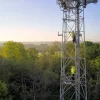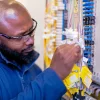Boldyn Networks Boost London’s 5G Mobile Cover via 200 Small Cells

Digital infrastructure firm Boldyn Networks has this morning announced that they’ve so far deployed over 200 5G capable small cells across busy parts of London, which can be harnessed by all the major mobile network operators (i.e. Vodafone / Three UK, O2 and EE) to boost their coverage, local capacity and mobile broadband performance.
Small cells are shoebox sized mobile (radio) base stations, which are designed to deliver limited coverage (usually up to around 100+ metres) and thus tend to be more focused on busy areas, specific sites or even indoor locations – it’s not uncommon to find these sitting on top of lampposts, CCTV poles or old payphone cubicles (i.e. more cost-effective than building new street assets or trying to secure wayleaves to access buildings etc.).
The ongoing deployment is part of a “broader initiative to enhance mobile connectivity in high-footfall urban areas through scalable, shared infrastructure, supporting London’s smart city ambitions“, said Boldyn Networks. It also supports the London Mayor’s manifesto to improve digital connectivity in London.
Advertisement
The new cells have thus been installed across some of the capital’s busiest areas, such as King’s Cross, Waterloo, London Bridge, Old Street, The Shard and Hyde Park Corner. Most of these have also been deployed at quite a rapid pace, with the operator often targeting a 3-month order-to-activation timeline.
The rollout is partly underpinned by Boldyn’s existing 20-year exclusive concession agreement with Transport for London (TfL), which includes work to build a new fibre network through the re-use of existing TfL ducts etc. This gives them access to more than 80,000 fibre-connected street assets, including on lighting columns, 2,000km of ducts and 400km of underground fibre, without the need for new planning permissions.
Brendan O’Reilly, CEO of UK & Ireland at Boldyn Networks, said:
“By overcoming traditional barriers such as planning delays and high deployment costs, we’ve unlocked a new model for rapid, sustainable connectivity. Through our partnership with TfL, we are delivering high-performance connectivity in high-footfall areas while preserving the city’s aesthetics and minimising disruption. Our small cell strategy is accelerating MNOs 5G rollout today across London and laying the foundations for the smarter, more connected capital of tomorrow.”
What’s not so clear from today’s announcement is the question of how many more small cells are likely to be deployed by Boldyn in London over the next few years, although some of this work is perhaps more demand-led and so tricky to predict.
Mark is a professional technology writer, IT consultant and computer engineer from Dorset (England), he also founded ISPreview in 1999 and enjoys analysing the latest telecoms and broadband developments. Find me on X (Twitter), Mastodon, Facebook, BlueSky, Threads.net and Linkedin.
« Rural UK Broadband Altnet Quickline Sees Revenues Grow to £3.9m
Advertisement
Leave a Reply Cancel reply
Privacy Notice: Please note that news comments are anonymous, which means that we do NOT require you to enter any real personal details to post a message and display names can be almost anything you like (provided they do not contain offensive language or impersonate a real person�s legal name). By clicking to submit a post you agree to storing your entries for comment content, display name, IP and email in our database, for as long as the post remains live.
Only the submitted name and comment will be displayed in public, while the rest will be kept private (we will never share this outside of ISPreview, regardless of whether the data is real or fake). This comment system uses submitted IP, email and website address data to spot abuse and spammers. All data is transferred via an encrypted (https secure) session.





















































What’s going to happen though when the boldyn contract finishes? Insane price hikes for networks so they leave? TFL finds a new supplier?
Boldyn are not a ‘supplier’ to TFL.
They hold a concession with TFL. Once the concession expires, TFL can opt to renew it with Boldyn, or go out to the market and have a new operator take over the infrastructure and the mobile operators will simply migrate to the new operator along with the infrastructure if it’s something they want to continue.
There does seem to be a big question over the viability of the concession at the moment.
Boldyn were supposed to have the majority of the underground covered by now, and it doesn’t seem to be continuing at pace anymore. i wonder if the commercials are struggling to cost in for all involved.
It’s not entirely clear from the article whether Boldyn have built these 200 small cells speculatively or whether they have been built to order from the MNOs